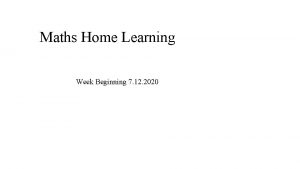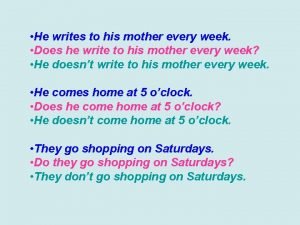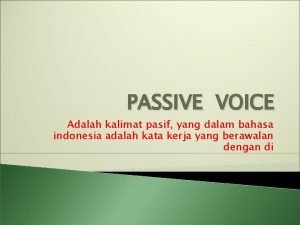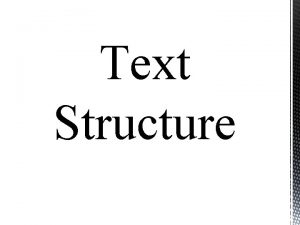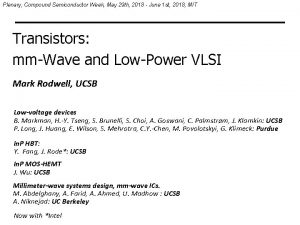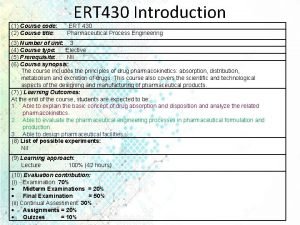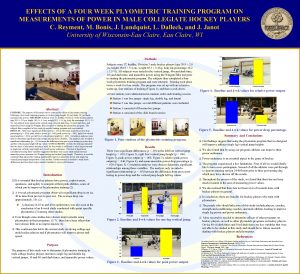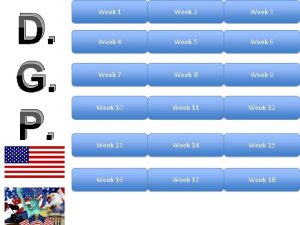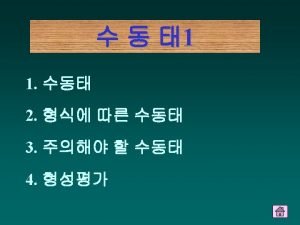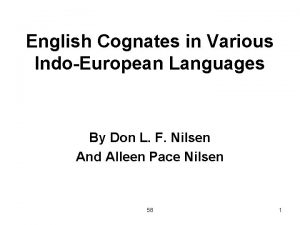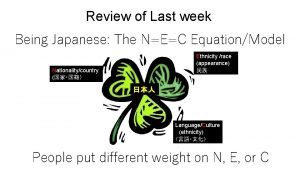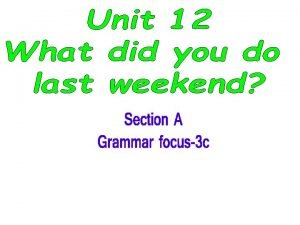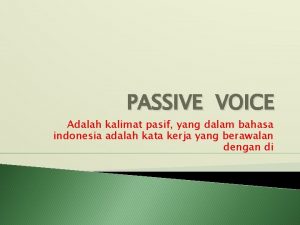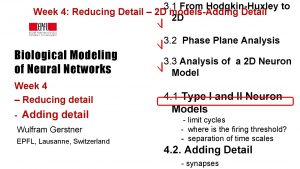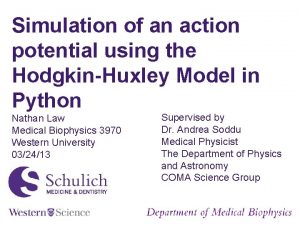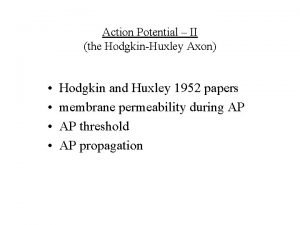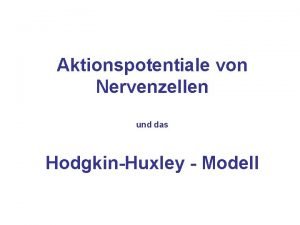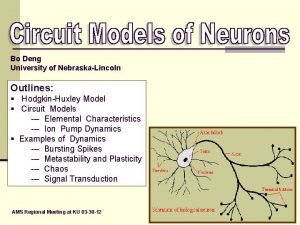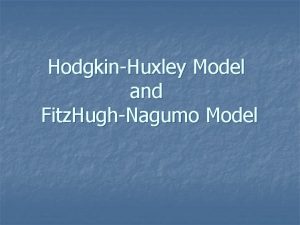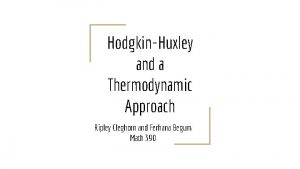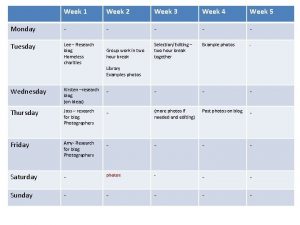3 1 From HodgkinHuxley to Week 3 part


































![Neuronal Dynamics – Quiz 3. 3 A. u-Nullclines [ ] On the u-nullcline, arrows Neuronal Dynamics – Quiz 3. 3 A. u-Nullclines [ ] On the u-nullcline, arrows](https://slidetodoc.com/presentation_image_h2/ba76ab1381754d681c0d15f60f36527f/image-35.jpg)



























- Slides: 62

3. 1 From Hodgkin-Huxley to Week 3 – part 1 : Reduction of 2 D the Hodgkin-Huxley Model - Overview: From 4 to 2 Biological Modeling of Neural Networks dimensions - Math. Detour 1: Exploiting similarities - Math. Detour 2: Separation of time scales 3. 2 Phase Plane Analysis - Role of nullclines Week 3 – Reducing detail: Two-dimensional neuron models Wulfram Gerstner EPFL, Lausanne, Switzerland 3. 3 Analysis of a 2 D Neuron Model - constant input vs pulse input - Math. Detour 3: Stability of fixed points 3. 4 Type. I and II Neuron Models

Neuronal Dynamics – 3. 1. Review : Hodgkin-Huxley Model cortical neuron Hodgkin-Huxley model Compartmental models

Neuronal Dynamics – 3. 1 Review : Hodgkin-Huxley Model Week 2: Cell membrane contains - ion channels - ion pumps -70 m. V + Na Dendrites (week 4): Active processes? assumption: passive dendrite point neuron spike generation action potential + K 2+ Ca Ions/proteins

Neuronal Dynamics – 3. 1. Review : Hodgkin-Huxley Model inside 100 Ka K m. V 0 Ion channels Ion pump Na outside Reversal potential ion pumps concentration difference voltage difference

Neuronal Dynamics – 3. 1. Review: Hodgkin-Huxley Model 100 C I m. V g. K 0 Hodgkin and Huxley, 1952 inside Ka g. Na gl Ion channels stimulus Ion pump Na outside 4 equations = 4 D system n 0(u) u u

Neuronal Dynamics – 3. 1. Overview and aims Can we understand the dynamics of the HH model? - mathematical principle of Action Potential generation? - constant input current vs pulse input? - Types of neuron model (type I and II)? (next week) - threshold behavior? (next week) Reduce from 4 to 2 equations Type I and ramp input/ constant input f-I curve type II models f f f-I curve I 0 I 0

Neuronal Dynamics – 3. 1. Overview and aims Can we understand the dynamics of the HH model? Reduce from 4 to 2 equations

Neuronal Dynamics – Quiz 3. 1. A - A biophysical point neuron model with 3 ion channels, each with activation and inactivation, has a total number of equations equal to [ ] 3 or [ ] 4 or [ ] 6 or [ ] 7 or [ ] 8 or more

Neuronal Dynamics – 3. 1. Overview and aims Toward a two-dimensional neuron model -Reduction of Hodgkin-Huxley to 2 dimension -step 1: separation of time scales -step 2: exploit similarities/correlations

Neuronal Dynamics – 3. 1. Reduction of Hodgkin-Huxley model stimulus m 0(u) h 0(u) u Math. Detour 1) dynamics of m are fast u

Neuronal Dynamics – Math. Detour 3. 1: Separation of time scales Two coupled differential equations Exercise 1 (week 3) (later !) Separation of time scales Reduced 1 -dimensional system

Neuronal Dynamics – 3. 1. Reduction of Hodgkin-Huxley model stimulus n 0(u) h 0(u) u 1) dynamics of m are fast 2) dynamics of h and n are similar u

Neuronal Dynamics – 3. 1. Reduction of Hodgkin-Huxley model Reduction of Hodgkin-Huxley Model to 2 Dimension -step 1: separation of time scales -step 2: exploit similarities/correlations Now !

Neuronal Dynamics – 3. 1. Reduction of Hodgkin-Huxley stimulus model 2) dynamics of h and n are similar Math. Detour u t 1 hrest nrest 0 h(t) n(t) t

Neuronal Dynamics – Detour 3. 1. Exploit similarities/correlations dynamics of h and n are similar h 1 -h Math. argument n 1 hrest nrest 0 h(t) n(t) t

Neuronal Dynamics – Detour 3. 1. Exploit similarities/correlations dynamics of h and n are similar at rest n 1 hrest nrest 0 h(t) n(t) t

Neuronal Dynamics – Detour 3. 1. Exploit similarities/correlations dynamics of h and n are similar (i) Rotate coordinate system (ii) Suppress one coordinate (iii) Express dynamics in new variable n 1 hrest nrest 0 h(t) n(t) t

Neuronal Dynamics – 3. 1. Reduction of Hodgkin-Huxley model 1) dynamics of m are fast 2) dynamics of h and n are similar w(t)

Neuronal Dynamics – 3. 1. Reduction of Hodgkin-Huxley model

NOW Exercise 1. 1 -1. 4: separation of time scales Exercises: 1. 1 -1. 4 now! 1. 5 homework Exerc. 9 h 50 -10 h 00 Next lecture: 10 h 15 A: - calculate x(t)! - what if t is small? 0 1 t ? t B: -calculate m(t) if t is small! - reduce to 1 eq.

3. 1 From Hodgkin-Huxley to Week 3 – part 1 : Reduction of 2 D the Hodgkin-Huxley Model - Overview: From 4 to 2 Biological Modeling of Neural Networks dimensions - Math. Detour 1: Exploiting similarities - Math. Detour 2: Separation of time scales 3. 2 Phase Plane Analysis - Role of nullclines Week 3 – Reducing detail: Two-dimensional neuron models Wulfram Gerstner EPFL, Lausanne, Switzerland 3. 3 Analysis of a 2 D Neuron Model - constant input vs pulse input - Math. Detour 3: Stability of fixed points 3. 4 Type. I and II Neuron Models

Neuronal Dynamics – Math. Detour 3. 1: Separation of time scales Two coupled differential equations Ex. 1 -A Exercise 1 (week 3) Separation of time scales Reduced 1 -dimensional system

Neuronal Dynamics – Math. Detour 3. 2: Separation of time scales Linear differential equation step

Neuronal Dynamics – Math. Detour 3. 2 Separation of time scales Two coupled differential equations x c ‘slow drive’ I

Neuronal Dynamics – Reduction of Hodgkin-Huxley model stimulus n 0(u) h 0(u) u dynamics of m is fast Fast compared to what? u

Neuronal Dynamics – Math. Detour 3. 2: Separation of time scales Two coupled differential equations Exercise 1 (week 3) Separation of time scales even more general Reduced 1 -dimensional system

Neuronal Dynamics – Quiz 3. 2. A- Separation of time scales: We start with two equations [ ] If reduded to then the system can be [ ] None of the above is correct. Attention I(t) can move rapidly, therefore choice [1] not correct

Neuronal Dynamics – Quiz 3. 2 -similar dynamics Exploiting similarities: A sufficient condition to replace two gating variables r, s by a single gating variable w is [ ] Both r and s have the same time constant (as a function of u) [ ] Both r and s have the same activation function [ ] Both r and s have the same time constant (as a function of u) AND activation functions that are identical after some additive rescaling [ ] Both r and s have the same time constant (as a function of u) AND activation functions that are identical after some multiplicative rescaling

Neuronal Dynamics – 3. 1. Reduction to 2 dimensions 2 -dimensional equation Enables graphical analysis! -Discussion of threshold - Constant input current vs pulse input -Type I and II - Repetitive firing Phase plane analysis

2 D Week 3 – part 1 : Reduction of the Hodgkin-Huxley Model - Overview: From 4 to 2 Biological Modeling of Neural Networks dimensions - Math. Detour 1: Exploiting similarities - Math. Detour 2: Separation of time scales 3. 2 Phase Plane Analysis - Role of nullclines Week 3 – Reducing detail: Two-dimensional neuron models Wulfram Gerstner EPFL, Lausanne, Switzerland 3. 3 Analysis of a 2 D Neuron Model - constant input vs pulse input - Math. Detour 3: Stability of fixed points 3. 4 Type. I and II Neuron Models

Neuronal Dynamics – 3. 2. Reduced Hodgkin-Huxley model stimulus

Neuronal Dynamics – 3. 2. Phase Plane Analysis/nullclines 2 -dimensional equation stimulus u-nullcline w-nullcline Enables graphical analysis! -Discussion of threshold -Type I and II

Neuronal Dynamics – 3. 2. Fitz. Hugh-Nagumo Model Math. Analysis, blackboard u-nullcline w-nullcline

Neuronal Dynamics – 3. 2. flow arrows Stimulus I=0 w Consider change in small time step Flow on nullcline Flow in regions between nullclines I(t)=0 Stable fixed point u
![Neuronal Dynamics Quiz 3 3 A uNullclines On the unullcline arrows Neuronal Dynamics – Quiz 3. 3 A. u-Nullclines [ ] On the u-nullcline, arrows](https://slidetodoc.com/presentation_image_h2/ba76ab1381754d681c0d15f60f36527f/image-35.jpg)
Neuronal Dynamics – Quiz 3. 3 A. u-Nullclines [ ] On the u-nullcline, arrows are always vertical [ ] On the u-nullcline, arrows point always vertically upward [ ] On the u-nullcline, arrows are always horizontal [ ] On the u-nullcline, arrows point always to the left [ ] On the u-nullcline, arrows point always to the right Take 1 minute, continue at 10: 55 B. w-Nullclines [ ] On the w-nullcline, arrows are always vertical [ ] On the w-nullcline, arrows point always vertically upward [ ] On the w-nullcline, arrows are always horizontal [ ] On the w-nullcline, arrows point always to the left [ ] On the w-nullcline, arrows point always to the right [ ] On the w-nullcline, arrows can point in an arbitrary direction

Neuronal Dynamics – 4. 2. Fitz. Hugh-Nagumo Model change b 1

Neuronal Dynamics – 3. 2. Nullclines of reduced HH model stimulus u-nullcline w-nullcline Stable fixed point

Neuronal Dynamics – 3. 2. Phase Plane Analysis 2 -dimensional equation stimulus Enables graphical analysis! Important role of - nullclines - flow arrows Application to neuron models

3. 1 From Hodgkin-Huxley to Week 3 – part 3: Analysis of a 2 D neuron model 2 D 3. 2 Phase Plane Analysis - Role of nullcline 3. 3 Analysis of a 2 D Neuron Model - pulse input - constant input -Math. Detour 3: Stability of fixed points 3. 4 Type I and II Neuron Models (next week)

Neuronal Dynamics – 3. 3. Analysis of a 2 D neuron model 2 -dimensional equation stimulus 2 important input scenarios - Pulse input - Constant input Enables graphical analysis!

Neuronal Dynamics – 3. 3. 2 D neuron model : Pulse input pulse input

Neuronal Dynamics – 3. 3. Fitz. Hugh-Nagumo Model : Pulse input w I(t)=0 u pulse input I(t) Pulse input: jump of voltage

Neuronal Dynamics – 3. 3. Fitz. Hugh-Nagumo Model : Pulse input FN model with Pulse input: jump of voltage/initial condition Image: Neuronal Dynamics, Gerstner et al. , Cambridge Univ. Press (2014)

Neuronal Dynamics – 3. 3. Fitz. Hugh-Nagumo Model DONE! Pulse input: - jump of voltage - ‘new initial condition’ - spike generation for large input pulses w I(t)=0 2 important input scenarios constant input: - graphics? - spikes? - repetitive firing? u Now

Neuronal Dynamics – 3. 3. Fitz. Hugh-Nagumo Model: Constant input w w-nullcline I(t)=I 0 Intersection point (fixed point) -moves -changes Stability u u-nullcline

NOW Exercise 2. 1: Stability of Fixed Point in 2 D w Exercises: 2. 1 now! 2. 2 homework Next lecture: 11: 42 - calculate stability - compare I(t)=I 0 u

3. 1 From Hodgkin-Huxley to Week 3 – part 3: Analysis of a 2 D neuron model 2 D 3. 2 Phase Plane Analysis - Role of nullcline 3. 3 Analysis of a 2 D Neuron Model - pulse input - constant input -Math. Detour 3: Stability of fixed points 3. 4 Type I and II Neuron Models (next week)

Neuronal Dynamics – Detour 3. 3 : Stability of fixed points. w w-nullcline stable? I(t)=I 0 u u-nullcline

Neuronal Dynamics – 3. 3 Detour. Stability of fixed points 2 -dimensional equation stimulus How to determine stability of fixed point?

Neuronal Dynamics – 3. 3 Detour. Stability of fixed points stimulus w I(t)=I 0 u stable saddle unstable

Neuronal Dynamics – 3. 3 Detour. Stability of fixed points w w-nullcline stable? zoom in: I(t)=I 0 u stable saddle unstable Math derivation now u-nullcline

Neuronal Dynamics – 3. 3 Detour. Stability of fixed points Fixed point at At fixed point zoom in:

Neuronal Dynamics – 3. 3 Detour. Stability of fixed points Fixed point at At fixed point zoom in:

Neuronal Dynamics – 3. 3 Detour. Stability of fixed points Linear matrix equation Search for solution Two solution with Eigenvalues

Neuronal Dynamics – 3. 3 Detour. Stability of fixed points Linear matrix equation Search for solution Stability requires: Two solution with Eigenvalues and

Neuronal Dynamics – 3. 3 Detour. Stability of fixed points stimulus w I(t)=I 0 u stable saddle unstable

Neuronal Dynamics – 3. 3 Detour. Stability of fixed points 2 -dimensional equation Now Back: Application to our neuron model Stability characterized by Eigenvalues of linearized equations

Neuronal Dynamics – 3. 3. Fitz. Hugh-Nagumo Model: Constant input w w-nullcline I(t)=I 0 Intersection point (fixed point) -moves -changes Stability u u-nullcline

Neuronal Dynamics – 3. 3. Fitz. Hugh-Nagumo Model: Constant input w w-nullcline I(t)=I 0 Intersection point (fixed point) -moves -changes Stability u u-nullcline

Neuronal Dynamics – 3. 3. Fitz. Hugh-Nagumo Model : Constant input FN model with constant input: u-nullcline moves limit cycle f Image: Neuronal Dynamics, Gerstner et al. , CUP (2014) f-I curve I 0

Neuronal Dynamics – Quiz 3. 4. A. Short current pulses. In a 2 -dimensional neuron model, the effect of a delta current pulse can be analyzed [ ] By moving the u-nullcline vertically upward [ ] By moving the w-nullcline vertically upward [ ] As a potential change in the stability or number of the fixed point(s) [ ] As a new initial condition [ ] By following the flow of arrows in the appropriate phase plane diagram B. Constant current. In a 2 -dimensional neuron model, the effect of a constant current can be analyzed [ ] By moving the u-nullcline vertically upward [ ] By moving the w-nullcline vertically upward [ ] As a potential change in the stability or number of the fixed point(s) [ ] By following the flow of arrows in the appropriate phase plane diagram

Computer exercise now Can we understand the dynamics of the 2 D model? The END for today Now: computer exercises Type I and ramp input/ constant input f-I curve type II models f f f-I curve I 0 I 0
 Week by week plans for documenting children's development
Week by week plans for documenting children's development Rametrics
Rametrics Technical description examples
Technical description examples Part part whole addition
Part part whole addition Parts of bar
Parts of bar Unit ratio definition
Unit ratio definition The phase of the moon you see depends on ______.
The phase of the moon you see depends on ______. Part part whole
Part part whole Two way anova minitab 17
Two way anova minitab 17 Atlas skews week 3
Atlas skews week 3 National pathology week
National pathology week /lessons/cntfk2dqjid2lq/week-7a
/lessons/cntfk2dqjid2lq/week-7a Every week his mother goes to university
Every week his mother goes to university I will introduce you to my boss this week
I will introduce you to my boss this week Bell ringer response sheet week 9 answer key
Bell ringer response sheet week 9 answer key The court will try the case next week passive voice
The court will try the case next week passive voice Last week we installed a kitty door
Last week we installed a kitty door 18ww pathway status
18ww pathway status Cfnc free application week
Cfnc free application week 5 a day language review week 20
5 a day language review week 20 Compound semiconductor week
Compound semiconductor week Fnf kat
Fnf kat Anglo saxon days of the week
Anglo saxon days of the week Dgp grammar
Dgp grammar Dgp week 10 answers
Dgp week 10 answers Dgp week 11
Dgp week 11 When is healthy eating week 2018
When is healthy eating week 2018 Lesson plan for revision week
Lesson plan for revision week 6 week plyometric training program
6 week plyometric training program Who wrote this
Who wrote this Enum week sunday monday
Enum week sunday monday Naidoc week meaning
Naidoc week meaning Days of the week and months of the year
Days of the week and months of the year The window was broken
The window was broken Teacher appreciation week
Teacher appreciation week Week 3 pico
Week 3 pico Last week of lent
Last week of lent Marriage rededication prayer
Marriage rededication prayer Kidney week abstract submission
Kidney week abstract submission Week 10 dgp
Week 10 dgp Week commencing today
Week commencing today The week has flown by
The week has flown by Medimios
Medimios Welcome to week 5
Welcome to week 5 Cfnc free application week
Cfnc free application week Last week in japanese
Last week in japanese One whole week
One whole week Stations of the cross holy week
Stations of the cross holy week Htcondor week
Htcondor week Okonkwo family tree
Okonkwo family tree What did you do last weekend
What did you do last weekend His landlord asked him to move
His landlord asked him to move Wat is week 36
Wat is week 36 Grammar boot camp worksheets
Grammar boot camp worksheets Cfnc free application week
Cfnc free application week Week 6
Week 6 School subjects and days of the week
School subjects and days of the week Htcondor week
Htcondor week 000 counting hundreds more each week
000 counting hundreds more each week Anglo saxon days of the week
Anglo saxon days of the week 8 day week
8 day week Antenatal card
Antenatal card River kwai bridge week
River kwai bridge week











